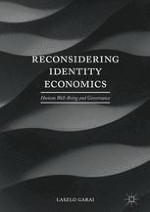2017 | OriginalPaper | Buchkapitel
2. The Double-Storied Structure of Social Identity
verfasst von : Laszlo Garai
Erschienen in: Reconsidering Identity Economics
Verlag: Palgrave Macmillan US
Aktivieren Sie unsere intelligente Suche, um passende Fachinhalte oder Patente zu finden.
Wählen Sie Textabschnitte aus um mit Künstlicher Intelligenz passenden Patente zu finden. powered by
Markieren Sie Textabschnitte, um KI-gestützt weitere passende Inhalte zu finden. powered by
